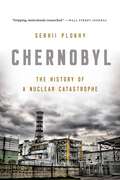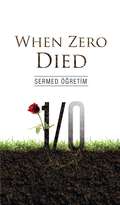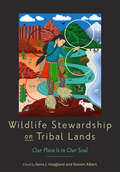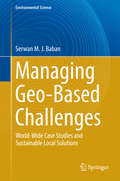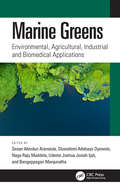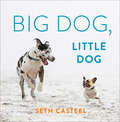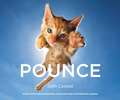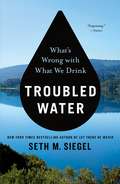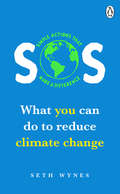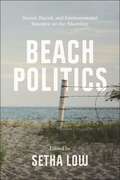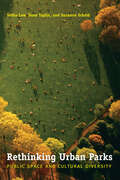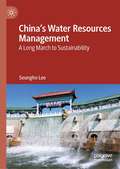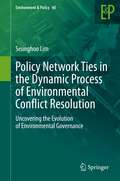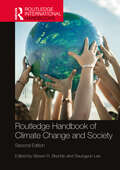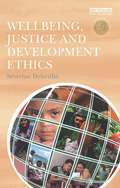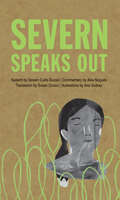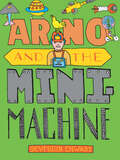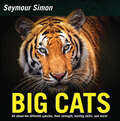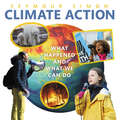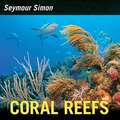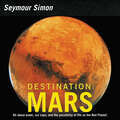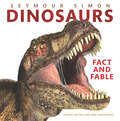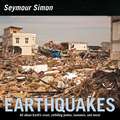- Table View
- List View
Chernobyl: The History of a Nuclear Catastrophe
by Serhii PlokhyFrom a preeminent historian of Eastern Europe, the definitive history of the Chernobyl nuclear disaster On the morning of April 26, 1986, Europe witnessed the worst nuclear disaster in history: the explosion of a reactor at the Chernobyl Nuclear Power Plant in Soviet Ukraine. Dozens died of radiation poisoning, fallout contaminated half the continent, and thousands fell ill. In Chernobyl, Serhii Plokhy draws on new sources to tell the dramatic stories of the firefighters, scientists, and soldiers who heroically extinguished the nuclear inferno. He lays bare the flaws of the Soviet nuclear industry, tracing the disaster to the authoritarian character of Communist party rule, the regime's control of scientific information, and its emphasis on economic development over all else. Today, the risk of another Chernobyl looms in the mismanagement of nuclear power in the developing world. A moving and definitive account, Chernobyl is also an urgent call to action.
When Zero Died
by Sermed OgretimAn old man shares his secret for happiness. The two halves of the brain debate the meaning of life. A young man explains why he chose life over death. An explorer and his team are trapped in a hostile environment, the fate of their extremely important mission in doubt. A common tradesman must solve an unanswered question to win the love of a princess; he seeks the answer with a reclusive hermit deep in the mountains. The stories in When Zero Died aren&’t ordinary: They draw on some of the oldest, classic forms in storytelling—allegory and myth—to explore what it means to live a thoughtful, selfless life in a chaotic, selfish world. They blur the line between science and religion to show how deeply interconnected the world, and everything in it, really is. Full of sharp intelligence, humor, and pathos, When Zero Died will make you think about how perfectly ordered and designed the universe is, and will force you to re-consider how you live your own life.
Wildlife Stewardship on Tribal Lands: Our Place Is in Our Soul
by Serra J. Hoagland and Steven AlbertThis groundbreaking book brings together Native American and Indigenous scholars, wildlife managers, legal experts, and conservationists from dozens of tribes to share their wildlife stewardship philosophies, histories, principles, and practices.Tribes have jurisdiction over some of the healthiest wild areas in North America, collectively managing over 56 million acres of land. This is no accident: in addition to a deep reverence for the land and a strong history of environmental stewardship, Native peoples implement some of the best fish and wildlife preservation and management practices on the continent. Wildlife Stewardship on Tribal Lands is the first comprehensive resource dedicated to the voices and expertise of Native scholars and wildlife professionals. In its pages, nearly one hundred Native and non-native wildlife conservationists, managers, and their collaborators share lessons to guide wildlife professionals in how best to incorporate native methods and how to work effectively with tribal stakeholders. The authors cover topics that include:• Guidelines for conducting research on tribal lands• Traditional ecological knowledge-based management models• The cultural and ecological importance of key species• Legal battles for treaty rights, management authority, and funding• First foods and food sovereignty • Fisheries and migratory bird management• Tribal perspectives on the Endangered Species Act• A history of modern fish and wildlife management on tribal landsThe content of this book is not limited to the invaluable reports of research findings, explications of methodologies, and case studies. Capturing oral histories and spiritual knowledge through interviews with tribal leaders and the work of Native artists and writers honors the holistic awareness of the land offered to readers of this unique volume. Ultimately, the contributors to Wildlife Stewardship on Tribal Lands demonstrate how tribal practices are pivotal guideposts for those seeking to protect and harness our natural resources in ways that can help reverse grievous biodiversity losses and ensure the health of our environment for future generations.Contributors: Scott Aikin, Steven Albert, John Antonio, Dale Becker, Bethany Berger, Kimberly Blaeser, Arthur Blazer, Michael Blumm, Michael Brydge, Ashley Carlisle, Frank Cerno Jr., Sally Carufel Williams, Guy Charlton, Samuel Chischilly, Bob Christensen, Gerald Cobell, Cody Desautel, Lauren Divine, Douglas W. Dompier, Ramona Emerson, Kari Eneas, James Fall, Julian J. Fischer, James R. Floyd, James Gensaw Sr., Michael I. Goldstein, Kim Gottschalk, Shaun Grassel, E. Richard Hart, Dylan R. Hedden-Nicely, Caleb Hickman, Serra J. Hoagland, Kraig Holmes, Nathan Jim, R. Roy Johnson, Jovon Jojola, Tamra Jones, Emily Sylvan Kim, Winona LaDuke, Stacy Leeds, Crystal Leonetti, Aaron P. Lestenkof, Chip Livingston, Lorraine Marquez Eiler, Eric Mellink, Paul I. Melovidov, Lara Mengak, Gary Paul Nabhan, Liliana Naves, Vern Northrup, nila northSun, Raymond E. Paddock III, Lizzy Pennock, Nicole Marie Pete, Aaron Poe, Georgiana Pongyesva, Ken Poynter, Mathis Quintana, Seafha Ramos, Janisse Ray, Vanessa L. Ray-Hodge, Amadeo Rea, Mitzi Reed, Marcie Rendon, Sarah F. Rinkevich, Bruce Robson, Andrea Rogers, Thomas C. Rothe, David E. Safine, Patty Schwalenberg, Kyle Secakuku, John Sewall, Todd Sformo, Richard T. Sherman, Ron Skates, Arthur M. Soukkala, Lawrence Stevens, Juliana Suzukawa, Julie Thorstenson, Gloria Tom, Christopher Tran, Craig van der Heiden, John Wheeler, Jessica Wiarda, Tiana Williams-Claussen.
Managing Geo-Based Challenges
by Serwan M. J. BabanThis book provides sound conceptual understanding of the current approach to management and decision making regarding geo-based challenges in developing countries that tend to suffer from information poverty and subjectivity and are reactive. The book also provides the necessary technical tools to energize research thinking and develop locally driven practical and sustainable solutions, ultimately moving management and decision making from being reactive to being proactive. This book fills a void as there are no published books to show the way forward or to present real case studies for this purpose. Case studies that utilize new technologies and scientific thinking are presented for developing sustainable management options based either on producing local applied research or on utilising relevant international research. These case studies are based on the author's first-hand experiences in arid/semi-arid (Iraq, Tunisia, Morocco and Jordan), temperate (UK) and tropical environments (Malaysia, the Caribbean region, Indonesia and Australia).
Marine Greens: Environmental, Agricultural, Industrial and Biomedical Applications
by Sesan Abiodun Aransiola, Oluwafemi Adebayo Oyewole, Naga Raju Maddela, Udeme Joshua Josiah Ijah, and Bangeppagari ManjunathaThis book provides an in-depth overview of marine greens and their environmental and biotechnological applications. It addresses concepts such as the niche adaptation strategies of marine greens in their natural habitats, as well as their global distribution, and factors affecting their distribution and proliferation.Marine greens are posited as an alternative to fossil fuels, mitigating global climate change and thereby fostering future environmental sustainability. In addition, the book explains the remediation of xenobiotics, wastewater, microplastics, marine debris and marine green contamination. Expert authors from around the world explore the industrial and agricultural applications of marine greens in the production of enzymes and marine bioenergy, and what is needed to improve its production potential.This is important reading for government and non-governmental organizations as well as industries and research institutions looking for ways to combat current industrial and environmental challenges.
Big Dog, Little Dog
by Seth CasteelFrom the bestselling photographer behind Underwater Dogs and Underwater Puppies, a new irresistibly cute concept featuring tiny dogs and giant dogs side by side.A collection of stunning photographs, each featuring two dogs: one big, one small. These unexpected pairs are utterly adorable, making this book the perfect gift for the biggest (or littlest) dog lover in your life, or the perfect coffee-table book for anyone who loves cute pups.
Pounce
by Seth CasteelPhotographer Seth Casteel's underwater photographs of dogs and babies have captivated an international audience. Now, Seth has found the perfect way to capture our other best friends: cats!A beautiful, funny gift book with more than 70 previously unpublished photographs, Pounce reveals adorable cats and kittens as they pounce and jump through the air, arms outstretched -- all in Casteel's signature up-close, mid-action style.
Underwater Dogs
by Seth CasteelThe exuberant, exhilarating photographs of dogs underwater that have become a sensationFrom the water's surface, it's a simple exercise: a dog's leap, a splash, and then a wet head surfacing with a ball, triumphant. But beneath the water is a chaotic ballet of bared teeth and bubbles, paddling paws, fur and ears billowing in the currents. From leaping lab to diving dachshund, the water is where a dog's distinct personality shines through; some lounge in the current, paddling slowly, but others arch their bodies to cut through the water with the focus and determination of a shark. In more than eighty portraits by award-winning pet photographer and animal rights activist Seth Casteel capture new sides of our old friends with vibrant underwater photography that makes it impossible to look away. Each image bubbles with exuberance and life, a striking reminder that even in the most loveable and domesticated dog, there are more primal forces at work. In Underwater Dogs, Seth Casteel gives playful and energetic testament to the rough-and-tumble joy that our dogs bring into our lives.
Underwater Puppies
by Seth CasteelNew York Times bestselling author and photographer Seth Casteel's follow-up to the phenomenal Underwater Dogs -- now with puppies.The world fell in love with swimming canines in Seth Casteel's first book, Underwater Dogs. Now, in more than 80 previously unpublished portraits of underwater puppies, we see man's best friends at their most playful and exuberant. Each vibrant and colorful underwater image shows off the wild and sublime range of emotions of puppies, cute and irresistible to the very last.
Troubled Water: What's Wrong with What We Drink
by Seth M. SiegelNew York Times bestselling author Seth M. Siegel shows how our drinking water got contaminated, what it may be doing to us, and what we must do to make it safe. If you thought America’s drinking water problems started and ended in Flint, Michigan, think again. From big cities and suburbs to the rural heartland, chemicals linked to cancer, heart disease, obesity, birth defects, and lowered IQ routinely spill from our taps. Many are to blame: the EPA, Congress, a bipartisan coalition of powerful governors and mayors, chemical companies, and drinking water utilities—even NASA and the Pentagon. Meanwhile, the bottled water industry has been fanning our fears about tap water, but bottled water is often no safer.The tragedy is that existing technologies could launch a new age of clean, healthy, and safe tap water for only a few dollars a week per person. Scrupulously researched, Troubled Water is full of shocking stories about contaminated water found throughout the country and about the everyday heroes who have successfully forced changes in the quality and safety of our drinking water. And it concludes with what America must do to reverse decades of neglect and play-it-safe inaction by government at all levels in order to keep our most precious resource safe.
SOS: What you can do to reduce climate change – simple actions that make a difference
by Seth Wynes'The most effective ways for individuals to reduce their carbon footprint' INewsClimate Change researcher, Seth Wynes, sets out in the simplest terms how you can make a real and positive impact.Make changes at home, at work, to how you shop, eat, live - start by finding one thing your family can change with this book and do it today. What you do matters - and the science proves it. How many actions can you tick of the list in this book to help save our planet?
Beach Politics: Social, Racial, and Environmental Injustice on the Shoreline
by Setha LowExplores how elites restrict access to public beaches around the globeBeaches are a beloved form of public space. Yet there has been an alarming global trend of restricting access to public sections of beaches to ensure that waterfront property owners can enjoy the shoreline exclusively or develop the land for commercial use.Beach Politics examines how over the past forty years, privatization of public space has accelerated with the help of both local governments and national corporations. On a local level, this can entail a group of wealthy neighbors purposely blocking off public beach access in their neighborhood: hiring security guards, building fences, or putting up “No Trespassing” signs to turn away members of the public who have every right to be there. On a state or national level, it can manifest as gated communities owned by private corporations sectioning off huge swaths of land, limiting access, or governments promoting private, rather than public, development along the shoreline. Whenever disputes about land use arise, the powers that be often side with private interests and the wealthy over those with fewer resources and, frequently, people of color. With the continuing threat of climate change, decisions about how and where to harden or protect the shoreline often limits public use.Focused on beaches, access to public space, and social justice, this book brings together powerful contributions illustrating how these issues are inextricably bound with socioeconomic status, racial segregation, and climate justice. Together they highlight how, through illegal actions and exclusionary legislation, the beach can be transformed from “a strip of nature” into a palimpsest of greed, racism, ecological disregard, and socioeconomic discrimination.
Rethinking Urban Parks: Public Space and Cultural Diversity
by Setha LowUrban parks such as New York City's Central Park provide vital public spaces where city dwellers of all races and classes can mingle safely while enjoying a variety of recreations. By coming together in these relaxed settings, different groups become comfortable with each other, thereby strengthening their communities and the democratic fabric of society. But just the opposite happens when, by design or in ignorance, parks are made inhospitable to certain groups of people. This pathfinding book argues that cultural diversity should be a key goal in designing and maintaining urban parks. Using case studies of New York City's Prospect Park, Orchard Beach in Pelham Bay Park, and Jacob Riis Park in the Gateway National Recreation Area, as well as New York's Ellis Island Bridge Proposal and Philadelphia's Independence National Historical Park, the authors identify specific ways to promote, maintain, and manage cultural diversity in urban parks. They also uncover the factors that can limit park use, including historical interpretive materials that ignore the contributions of different ethnic groups, high entrance or access fees, park usage rules that restrict ethnic activities, and park “restorations” that focus only on historical or aesthetic values. With the wealth of data in this book, urban planners, park professionals, and all concerned citizens will have the tools to create and maintain public parks that serve the needs and interests of all the public.
China's Water Resources Management: A Long March to Sustainability
by Seungho LeeThis book investigates water resources management and policy in China over the last two decades with a core focus on the role of water for socioeconomic development and sustainability. Recent policies, such as the Three Red Lines and the Water Ten Plan are evaluated for sustainable water supply, use and quality control. The book appraises solutions through demand management, water rights and pollution trading, virtual water and water footprint. Supply management is discussed taking examples from the Three Gorges Dam and the South North Water Transfer Project. The water market is investigated uncovering the active engagement of the private sector and includes discussions on how transboundary rivers demonstrate China’s engagement with its riparian countries for benefit sharing. This book will be an invaluable reference for researchers in the field as well as practitioners and students who have an interest in water and development in China.
Policy Network Ties in the Dynamic Process of Environmental Conflict Resolution: Uncovering the Evolution of Environmental Governance (Environment & Policy #60)
by Seunghoo LimExtensive previous research has investigated environmental conflict management issues in networked settings and the design of policy networks, but the emergence and evolution of self-organizing policy networks are still not fully understood. Especially misunderstood is the problem of how the multiple motivations or incentives of competing policy actors in conflictual situations affect their structures of interaction, as this issue has not been studied systematically. This book aims to address the following research questions: how do policy stakeholders cope strategically with collective action or environmental conflict resolution? How do they utilize or maintain formal and informal policy networks to resolve problems effectively? What motivates them to engage or be involved in collaborative or conflictual networks? What influences their networking or their decisions on partner selection for conflict resolution? This book consists of four studies. The goal of the first study is to examine the form of a policy network by focusing on how policy networks emerge and evolve at the micro-level to solve collective action dilemmas endemic to decentralized and democratized policy decision-making processes, particularly in the environmental conflict resolution arena. The goal of the second study is to examine the main policy actors and structural characteristics of network governance evolution in the dynamic process of environmental conflict resolution. The goal of the third study is to highlight the role of policy tie formality in the evolution of multiplex ties in the environmental conflict resolution process. The goal of the fourth study is to demonstrate the relationships between patterns of interactions among policy actors and their modified and adjusted strategic behaviours within policy networks and across advocacy coalitions.
Routledge Handbook of Climate Change and Society (Routledge International Handbooks)
by Steven R. Brechin Seungyun LeeRoutledge Handbook of Climate Change and Society is a comprehensive guide that provides insights into the multifaceted relationship between climate change and society and covers a wide array of topics, disciplines, and cultures, from the latest trends in weather patterns to the issue of climate (in)justice. The second edition, which is overwhelmingly comprised of all-new essays, is an indispensable resource for those interested in understanding the complexities of climate change and its societal implications.The book contains seven thematically organized sections examining the various aspects of climate change and its intersection with our society: Climate Change in the Natural and Social Sciences; Human Population, Movement, and Health; Economics, Energy, and Consumption; Urban Climate Resiliency; Technological Innovations and Pitfalls; Gender, Poverty, and Justice; and Politics and Governance. Each part provides a unique and important perspective for understanding the challenges as well as opportunities presented by climate change.Through original research findings and critical analysis, this book sheds light on the urgent need for interdisciplinary approaches to tackle climate change effectively. By examining the intersectionality of climate change with various social, economic, and political factors, it offers valuable insights for researchers, policymakers, activists, and anyone concerned about the future of our planet. With a forward-looking perspective that emphasizes optimism and resilience, this book serves as a tool for fostering hope and collective action in the face of climate change challenges.
Wellbeing, Justice and Development Ethics
by Severine DeneulinThe question of the meaning of progress and development is back on the political agenda. How to frame this discontent and search for new alternatives when either Marxism or liberalism no longer provides a satisfactory framework? This book introduces in an accessible way the capability approach, first articulated by Amartya Sen in the early 1980s. Written for an international audience, but rooted in the Latin American reality - a region with a history of movements for social justice - the book argues that the capability approach provides to date, the most encompassing and compelling ethical framework with which to construct action for improving people’s wellbeing and reducing injustices in the world. This book outlines in a clear and concrete way what the capability approach is and its significance for the social sciences and policy. It describes the distinctiveness of the approach as an ethical framework for action and aims to stimulate critical reflection on current economic and social practices as well as providing a language with which to modify them within human wellbeing concerns. Comprehensive, practical and nuanced in its treatment of the capability approach, this highly original volume gives students, researchers and professionals in the field of development an innovative framing of the capability approach as a 'language' for action and provides specific examples of how it has made a difference.
Severn Speaks Out (Speak Out #1)
by Severn Cullis-SuzukiBefore Greta Thunberg there was Severn Cullis-Suzuki, whose 1992 Earth Summit speech made her known as “the girl who silenced the world for five minutes.” Severn Cullis-Suzuki was only twelve years old when she addressed the whole world and asked: What are you doing to the Earth, our home? How far can human greed go? Young Severn looked at the world leaders in attendance and said, “I’m only a child, and I don’t have all the solutions, but I want you to realize, neither do you!” She entreated those world leaders to make their actions reflect their words and to protect the Earth for generations to come. Severn’s speech is even more urgent today than it was thirty years ago. Beautiful illustrations accompany her words in this first book in the Speak Out series, followed by an analysis written by Alex Nogués that gives readers more detail about Severn’s life and the context of her speech, while highlighting the most powerful and persuasive points of her address. The Speak Out series publishes the most inspiring speeches of our times, then deconstructs them to give young readers a deeper understanding of global issues and the power of language to influence them. Key Text Features biographical information definitions explanation facts headings historical context illustrations informational note Correlates to the Common Core State Standards in English Language Arts: CCSS.ELA-LITERACY.RI.5.8 Explain how an author uses reasons and evidence to support particular points in a text, identifying which reasons and evidence support which point(s). CCSS.ELA-LITERACY.RI.6.3 Analyze in detail how a key individual, event, or idea is introduced, illustrated, and elaborated in a text (e.g., through examples or anecdotes). CCSS.ELA-LITERACY.RI.6.5 Analyze how a particular sentence, paragraph, chapter, or section fits into the overall structure of a text and contributes to the development of the ideas. CCSS.ELA-LITERACY.RI.6.6 Determine an author's point of view or purpose in a text and explain how it is conveyed in the text.
Arno and the MiniMachine
by Seymour ChwastA prescient and humorous tale of a boy's futuristic life gone haywire with the interruption of ... nature.GO BACK TO YOUR CLASS, says the MiniMachine.The brightly moving thing flutters into Arno's hand. It feels warm. Attached to a foot is a label, reading: BIRD.Two hundred years in the future, Arno's pre-programmed, machine-controlled day takes an unexpected turn when nature intercedes. Arno wakes each morning when his personalized "MiniMachine" tells him it's time. The MiniMachine squawks at him all day: "Eat your Instant Mealtime," "Wait for the school jet," "Go to your electric tuba lesson," "Do not step off the Power Path"..... But Arno's curiosity and a little yellow bird lead Arno off his pre-programmed track. "Go Back to Your Class!" squawks the MiniMachine with increasing alarm. Arno's mischievousness will delight young readers. And Seymour Chwast's illustrations, including his Seuss-like mechanical inventions, are both charmingly old-fashioned and presciently futuristic. A gentle corrective to our infatuation with electronics, Arno and the MiniMachine is a sweet reminder of the joy of nature and following one's own path.
Big Cats: Revised Edition
by Seymour SimonIn this completely updated edition of Big Cats, award-winning writer Seymour Simon celebrates the grace and power of lions, tigers, leopards, jaguars, cheetahs, pumas, and snow leopards. Readers will learn all about how they hunt, care for their young, and rest in their varied natural habitats. This nonfiction picture book is packed with information and beautiful color photographs. Cat fans and kids ages 6 to 10 looking for facts, whether for a report or just for fun, will find much to like in Big Cats.This updated edition includes:Author’s noteStunning full-color photographsGlossaryIndexAdditional reading sourcesSupports the Common Core Learning Standards, Next Generation Science Standards, and the Science, Technology, Engineering, and Math (STEM) standards.
Climate Action: What Happened and What We Can Do
by Seymour SimonMeet the young activists who are using their voices and minds to fight climate change. Did you know that the past five years have been the hottest ever recorded? Or that over seven million people participated in the global Climate Strike? We’re facing a very real problem, but there’s hope. Everyone is affected by climate change. Reading Climate Action: What Happened and What We Can Do is the perfect introduction not only to the dramatic effects of climate change, but to the solutions. Learn how our behavior and actions have led us to this point, hear from kids around the world dealing with extreme storms, wildfires, and sea level rise, and discover what scientists, youth activists, and ordinary citizens are doing to protect their communities. Divided into eight sections for easy browsing and with over fifty photographs, captions, charts, and graphs, this nonfiction book is an excellent choice to share in the classroom and for homeschooling for kids ages 6 and up. Also includes a glossary to supplement the text, author’s note, and index. Climate Action is the latest of Seymour Simon’s nonfiction science books. His books are regularly honored by the National Science Teacher's Association.
Coral Reefs
by Seymour SimonSeymour Simon knows how to explain science to kids and make it fun. He was a teacher for more than twenty years, has written more than 250 books, and has won multiple awards. <P><P>In Coral Reefs, Simon introduces elementary-school readers to the oceans’ reefs through wonderful descriptions and stunning full-color photographs. He encourages appreciation of the ecology of coral reefs, explains why they are in danger, and suggests ways kids can help save the endangered reefs. Lexile Measure: NC1110L
Destination: Revised Edition
by Seymour SimonAward-winning science writer Seymour Simon explores the Red Planet through fascinating facts and amazing full-color photographs. Readers will learn about the recent discovery of water, the Valles Marineris—the biggest valley on Mars—the ice caps, recent expeditions, and more. This nonfiction picture book is an excellent choice to share during homeschooling, in particular for children ages 6 to 8. It’s a fun way to learn to read and as a supplement for activity books for children.This updated edition includes:author’s notestunning full-color photographsglossaryindexwebsites and additional reading sourcesSupports the Common Core Learning Standards, Next Generation Science Standards and the Science, Technology, Engineering, and Math (STEM) standards.
Dinosaurs: Fact and Fable
by Seymour Simon“If you love dinosaurs, you’ll love this book."— Steve Brusatte, paleontologist at the University of Edinburgh and New York Times bestselling author of The Rise and Fall of the DinosaursJoin award-winning science writer Seymour Simon as he separates fact from fiction in a brilliant exploration of some of the most fascinating creatures to ever roam the planet: dinosaurs! This nonfiction picture book is an excellent choice for both shared and independent reading during homeschooling and classroom learning, in particular for children ages 6 to 8.Scientists have dug up and uncovered many facts about dinosaurs—and in the process, they have come across many myths. This picture book digs deep into the Age of Dinosaurs, covering topics such as fossilization, plate tectonics, dinosaur diets, paleontology, extinction theories, dinosaur relatives, and more!Get ready to learn what we know about dinosaurs and what we still don’t know, and about the amazing new discoveries being made every single day.Perfect for young scholars’ school reports, Dinosaurs: Fact and Fable features clear text, vibrantly colored pages, engaging sidebars, and stunning full-color illustrations and photographs. This book includes an author's note, a glossary, a timeline, and an index and supports the Common Core State Standards.Check out these other Seymour Simon books about animals:Big CatsButterfliesCatsCrocodiles & AlligatorsDogsDolphinsElephantsFrogsGorillasHorsesInsectsPenguinsSea CreaturesSnakesSpidersWhalesWild BabiesWolves
Earthquakes
by Seymour SimonSeymour Simon knows how to explain science to kids and make it fun. He was a teacher for over twenty years, has written more than 250 books, and has won multiple awards. In Earthquakes, Simon introduces elementary-school readers to earthquakes through engaging descriptions and stunning full-color photographs. He teaches readers why and how earthquakes happen and the damage they can cause through pictures, diagrams, and maps. He also gives real life examples of earthquakes that have occurred all over the world. This book includes a glossary and index. Supports the Common Core State Standards
